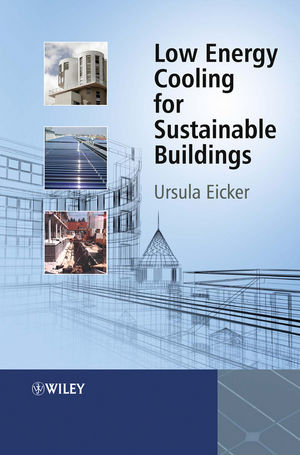Low Energy Cooling for Sustainable BuildingsISBN: 978-0-470-69744-3
Hardcover
276 pages
April 2009
 This is a Print-on-Demand title. It will be printed specifically to fill your order. Please allow an additional 10-15 days delivery time. The book is not returnable.
|
||||||
About the Author.
1 Energy Demand of Buildings.
1.1 Residential Buildings.
1.1.1 Heating Energy.
1.1.2 Domestic Hot Water.
1.1.3 Electricity Consumption.
1.2 Office Buildings.
1.2.1 Heating Energy.
1.2.2 Electricity Consumption.
1.2.3 Air Conditioning.
1.3 Conclusions.
2 Façades and Summer Performance of Buildings.
2.1 Review of Façade Systems and Energy Performance.
2.1.1 Single Façades.
2.1.2 Double Façades.
2.1.3 Modelling of Ventilated Façades.
2.2 Experimental Results on Total Energy Transmittance.
2.2.1 Laboratory Experiments.
2.2.2 Building Experiments.
2.3 Cooling Loads through Ventilation Gains.
2.3.1 Double Façade Experiments.
2.3.2 Parameter Study Using Simulation.
2.4 Energy Production from Active Façades.
2.4.1 Thermal and Electrical Energy Balance of the Façade.
2.5 Conclusions on Façade Performance.
3 Passive Cooling Strategies.
3.1 Building Description and Cooling Concepts.
3.1.1 Lamparter Building, Weilheim.
3.1.2 Rehabilitated Office Building in Tübingen.
3.1.3 Low-energy Office Building in Freiburg.
3.2 Passive Night Ventilation Results.
3.2.1 Internal Loads and Temperature Levels.
3.2.2 Air Changes and Thermal Building Performance.
3.2.3 Simulation of Passive Cooling Potential.
3.2.4 Active Night Ventilation.
3.3 Summary of Passive Cooling.
4 Geothermal Cooling.
4.1 Earth Heat Exchanger Performance.
4.1.1 Earth to Air Heat Exchanger in a Passive Standard Office Building.
4.1.2 Performance of Horizontal Earth Brine to Air Heat Exchanger in the ebök Building.
4.1.3 Performance of Vertical Earth Brine to Air Heat Exchanger in the SIC Building.
4.1.4 Modelling of Geothermal Heat Exchangers.
4.1.5 Conclusions on Geothermal Heat Exchangers for Cooling.
5 Active Thermal Cooling Technologies.
5.1 Absorption Cooling.
5.1.1 Absorption Cycles.
5.1.2 Solar Cooling with Absorption Chillers.
5.2 Desiccant Cooling.
5.2.1 Desiccant Cooling System in the Mataró Public Library.
5.2.2 Desiccant Cooling System in the Althengstett Factory.
5.2.3 Monitoring Results in Mataró.
5.2.4 Monitoring Results in Althengstett.
5.2.5 Simulation of Solar-Powered Desiccant Cooling Systems.
5.2.6 Cost Analysis.
5.2.7 Summary of Desiccant Cooling Plant Performance.
5.3 New Developments in Low-Power Chillers.
5.3.1 Development of a Diffusion–Absorption Chiller.
5.3.2 Liquid Desiccant Systems.
6 Sustainable Building Operation Using Simulation.
6.1 Simulation of Solar Cooling Systems.
6.1.1 Component and System Models.
6.1.2 Building Cooling Load Characteristics.
6.1.3 System Simulation Results.
6.1.4 Influence of Dynamic Building Cooling Loads.
6.1.5 Economic Analysis.
6.1.6 Summary of Solar Cooling Simulation Results.
6.2 Online Simulation of Buildings.
6.2.1 Functions and Innovations in Building Management Systems.
6.2.2 Communication Infrastructure for the Implementation of Model-Based Control Systems.
6.2.3 Building Online Simulation in the POLYCITY Project.
6.3 Online Simulation of Renewable Energy Plants.
6.3.1 Photovoltaic System Simulation.
6.3.2 Communication Strategies for Simulation-Based Remote Monitoring.
6.3.3 Online Simulation for the Commissioning and Operation of Photovoltaic Power Plants.
6.3.4 Summary of Renewable Energy Plant Online Simulation.
7 Conclusions.
References.
Index.



